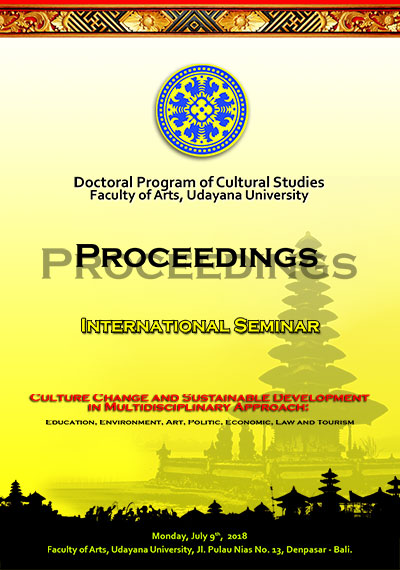BORAN DANCE, BETWEEN IDENTITY AND DANCE OF LAMONGAN TRADITION IN THE PERSPECTIVE OF CULTURAL STUDIES
Abstract
Boran Dance which was originally created with the aim of following the traditional art festival organized by the East Java art council currently transformed into a traditional dance Lamongan. Stunted Boran dance is transformed into a traditional dance Lamongan does not appear suddenly but the results of the ideology of the ruling class (government Lamongan) through various systems and institutions, ranging from media, advertising, educational institutions and so on. This practice the researchers consider as an unnatural problem because the context of the construction of dance is outside of the traditional aesthetic rules of dance. Referring to the phenomenon of the researcher will analyze this problem with the perspective of western philosophy that is by approach theories of cultural studies. Through the approach of theories of cultural studies researchers trying to peel the extent to which Boran dance is transforming into traditional dance Lamongan and become Lamongan dance identity. Through critical thinking Gramsci, researchers try to analyze how far Boran dance transform itself into traditional Lamongan dance, and is there any legality of hegemony also in it. So as to make dance boran, as the identity of traditional dance Lamongan. Boran Dance was born from an iven of traditional art performances organized by the East Java Arts Council. Because to the existence and success of this dance is transformed from festival dance into traditional Lamongan dance. This dance is currently known by the general public as the identity of the traditional dance of Lamongan. From the researcher's perspective, this dance is far from the traditional dance rule. If looking from the concept can indeed be viewed as the art of tradition, but from the background of the creation of this dance is not the dance tradition and legitimacy Boran dance as traditional Lamongan dance not separated from the hegemonic contract of the dominant class to the subordinate class. The strength of this legitimacy can not be separated from the power of the ruler (upper class). The success of Boran dance at the National level is able to conjure up individual consciousness. This success is also strengthened through various aspects and areas that legitimize the ruling hegemony of Boran dance identity as traditional Lamongan dance.
Downloads
References
Sugiyono. 2005. Memahami Penelitian Kualitatif. Bandung: CV. Alfabeta. Simon Roger. 2004. Gagasan-gagasan Politik Gramsci. Yogyakarta: Pustaka Pelajar. Yusuf, Lubis, A. 2016. Pemikiran Kritis Kontemporer: Dari Teori Kritis, Cultural Studies, Feminisme, Poatkolonialisme, Hingga Multikulturalisme. Jakarta: Rajawali Pers.

This work is licensed under a Creative Commons Attribution-NonCommercial-ShareAlike 4.0 International License.





